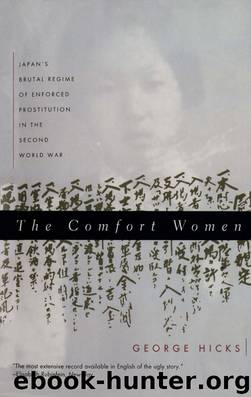The Comfort Women by George Hicks

Author:George Hicks
Language: eng
Format: epub
ISBN: 9780393245530
Publisher: W. W. Norton & Company
Published: 2014-02-17T16:00:00+00:00
As in many war crimes trials, the court proceedings essentially became a simple ratification of the findings of earlier investigations. They were in any case something of a legal hybrid, as the various nations involved in war trials all had varied codes and procedures.
The Japanese-South Korean Basic Treaty of 1965
In Korea, more affected than any other country by the comfort system, the comfort women after the war melted into the general population. The issue of rape and forced prostitution never came to trial. Nor was it part of the compensation talks between the male-dominated governments of both countries. Korea had only a brief peace before the chaos of the Korean War descended on it in June 1950, hostilities not ending until July 1953. The result of this fratricidal war was a divided Korea and a resurgent Japan whose post-war economic recovery was partially caused by the war.
It was not until 1965 that the Japanese-South Korean Basic Treaty was signed. It gave the South Korean government the right to handle all matters of compensation for wartime suffering. The long delay had been caused by South Korea President Syngman’s Rhee’s refusal to deal realistically with the Japanese. During his presidency from 1948 to 1960 he refused normal diplomatic contacts, demanding an astronomical compensation sum from Japan without room for negotiation.
Debate on the comfort women issue and on the validity of demands made by ex-comfort women and associated groups has hinged on this 1965 treaty. Important developments which led up to it began with the freezing by the American Occupation administration of Japanese assets in South Korea, first public and then private ones. In Soviet-controlled North Korea, all Japanese property was nationalised by the Provisional People’s Committee. Such property in South Korea was only formally assigned to the local authority by the South Korea-US Agreement of 1958.
Korea was not a party to the 1952 San Francisco Peace Treaty which ended the war between Japan and the Allies. As a Japanese colony, it could not be regarded as a sovereign belligerent on either side—although North Korea claimed to have been in a state of war with Japan by virtue of its guerrilla activities in China, in collaboration with the Communists. The Peace Treaty did, however, restore Korean sovereignty, and provide for a legal settlement of claims by negotiations between Korea and Japan. This was the basis of the 1965 treaty. In earlier phases of negotiations, the Japanese treated questions as a matter of two-way claims. The American Occupation administration, however, ruled out Japanese claims, assigning all frozen Korean property to South Korea.
Claims by South Koreans included debts owed to them, such as unpaid wages, savings held in Japan, and specified damages. All these had to be documented. Documentation was, however, problematic, because of the widespread chaos of the Pacific and Korean wars. Administrative acts by the Japanese in accordance with then-current Japanese law were not clearly subject to compensation, since Japanese sovereignty over Korea had been internationally recognised in the same way as other colonial regimes.
Download
This site does not store any files on its server. We only index and link to content provided by other sites. Please contact the content providers to delete copyright contents if any and email us, we'll remove relevant links or contents immediately.
The Radium Girls by Kate Moore(11970)
100 Deadly Skills by Clint Emerson(4877)
Rise and Kill First by Ronen Bergman(4739)
The Templars by Dan Jones(4656)
The Doomsday Machine by Daniel Ellsberg(4449)
The Rape of Nanking by Iris Chang(4165)
Killing England by Bill O'Reilly(3968)
Hitler in Los Angeles by Steven J. Ross(3923)
Stalin by Stephen Kotkin(3918)
12 Strong by Doug Stanton(3525)
Hitler's Monsters by Eric Kurlander(3290)
Blood and Sand by Alex Von Tunzelmann(3164)
The Code Book by Simon Singh(3136)
Darkest Hour by Anthony McCarten(3096)
The Art of War Visualized by Jessica Hagy(2972)
Hitler's Flying Saucers: A Guide to German Flying Discs of the Second World War by Stevens Henry(2731)
Babylon's Ark by Lawrence Anthony(2648)
The Second World Wars by Victor Davis Hanson(2502)
Tobruk by Peter Fitzsimons(2476)
